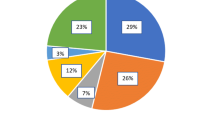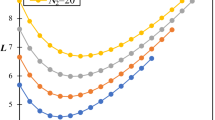Abstract
The study proposes a purchasing model, which considers a case of time-varying deterioration, partial back-ordering that depends on the waiting time for backlogging, and time value of money over a finite horizon. The model integrates all possible real-world situations that may happen in dealing with an order quantity. We derive the lower bound of the replenishment for a specific planning horizon and propose a procedure to solve the problem.
Similar content being viewed by others
References
Whitin TM (1957) Theory of inventory management. Princeton University Press, Princeton
Chowdhury MR, Chaudhuri KS (1983) An order-level inventory model for deteriorating items with finite rate of replenishment. Opsearch 20(2):99–106
Dave U (1986) An order-level inventory model for deteriorating items with variable instantaneous demand and discrete opportunities for replenishment. Opsearch 23(1):244–249
Bahari-Kashani H (1989) Replenishment schedule for deteriorating items with time proportional demand. J Oper Res Soc 40(1):75–81
Wee HM (1995) A deterministic lot-size inventory model for deteriorating items with shortages on a declining market. Comput Oper Res 22(3):345–356
Hariga MA, Al-Alyan A (1997) A lot sizing heuristic for deteriorating items with shortages in growing and declining markets. Comput Oper Res 24(11):1075–1083
Benkherouf L (1998) Note on a deterministic lot-size inventory model for deteriorating items with shortages and declining markets. Comput Oper Res 25(1):63–65
Papachristos S, Skouri K (2001) An optimal replenishment policy for deteriorating items with time-varying demand and partial-exponential type-backlogging. Oper Res Lett 27:175–184
Yang PC, Wee HM (2002) A single-vendor and multiple-buyers production-inventory policy for a deteriorating item. Eur J Oper Res 143:570–581
Rau H, Wu MY, Wee HM (2003) Integrated inventory model for deteriorating items under a multi-echelon supply chain environment. Int J Prod Econ 86:155–168
Deb M, Chaudhuri KS (1986) An EOQ model for items with finite rate of production and variable rate of deterioration. J Oper Res Soc India 23(1):175–181
Goswami A, Chaudhuri KS (1992) Variations of order-level inventory models for deteriorating items. Int J Prod Econ 27(2):111–117
Giri BC, Goswami A, Chaudhuri KS (1996) An EOQ model for deteriorating items with time varying demand and costs. J Oper Res Soc 47(11):1398–1405
Wu JW, Lin C, Tan B, Lee WC (2000) An EOQ inventory model with time varying demand and Weibull deterioration with shortage. Int J Syst Sci 31(6):677–683
Lin C, Tan B, Lee WC (2000) An EOQ model for deteriorating items with time-varying demand and shortages. Int J Syst Sci 31(3):391–400
Chu P, Chen PS (2001) A note on an inventory model for deteriorating items and time-varying demand. Math Method Oper Res 53:297–307
Goyal SK, Giri BC (2001) Recent trends in modeling of deteriorating inventory. Eur J Oper Res 134:1–16
Chang HJ, Dye CY (1999) An EOQ model for deteriorating items with time varying demand and partial backlogging. J Oper Res Soc 50(10):1176–1182
Trippi RR, Lewin DE (1974) A present value for formulation of the classical EOQ problem. Decision Sci 5:30–35
Moon I, Yun W (1993) An economic order quantity model with a random planning horizon. Eng Econ 39:77–83
Bose S, Goswami A (1995) An EOQ model for deteriorating items with linear time-dependent demand rate and shortages under inflation and time discounting. J Oper Res Soc 46:771–782
Cheung KI (1998) A continuous review inventory model with a time discount. IIE Trans 30:747–757
Chung KJ, Tsai SF (2001) Inventory systems for deteriorating items with shortages and a linear trend in demand-taking account of time value. Comput Oper Res 28:915–934
Chung KJ, Lin CN (2001) Optimal inventory replenishment models for deteriorating items taking account of time discounting. Comput Oper Res 28:67–83
Wolfram S (1996) The Mathematica book, 3rd edn. Cambridge University Press, Cambridge
Author information
Authors and Affiliations
Corresponding author
Rights and permissions
About this article
Cite this article
Lin, Y., Lin, C. Purchasing model for deteriorating items with time-varying demand under inflation and time discounting. Int J Adv Manuf Technol 27, 816–823 (2006). https://doi.org/10.1007/s00170-004-2236-y
Received:
Accepted:
Published:
Issue Date:
DOI: https://doi.org/10.1007/s00170-004-2236-y




